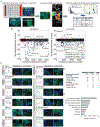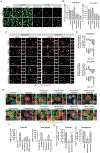Small-Molecule Modulation of TDP-43 Recruitment to Stress Granules Prevents Persistent TDP-43 Accumulation in ALS/FTD
- PMID: 31272829
- PMCID: PMC6728177
- DOI: 10.1016/j.neuron.2019.05.048
Small-Molecule Modulation of TDP-43 Recruitment to Stress Granules Prevents Persistent TDP-43 Accumulation in ALS/FTD
Abstract
Stress granules (SGs) form during cellular stress and are implicated in neurodegenerative diseases such as amyotrophic lateral sclerosis and frontotemporal dementia (ALS/FTD). To yield insights into the role of SGs in pathophysiology, we performed a high-content screen to identify small molecules that alter SG properties in proliferative cells and human iPSC-derived motor neurons (iPS-MNs). One major class of active molecules contained extended planar aromatic moieties, suggesting a potential to intercalate in nucleic acids. Accordingly, we show that several hit compounds can prevent the RNA-dependent recruitment of the ALS-associated RNA-binding proteins (RBPs) TDP-43, FUS, and HNRNPA2B1 into SGs. We further demonstrate that transient SG formation contributes to persistent accumulation of TDP-43 into cytoplasmic puncta and that our hit compounds can reduce this accumulation in iPS-MNs from ALS patients. We propose that compounds with planar moieties represent a promising starting point to develop small-molecule therapeutics for treating ALS/FTD.
Keywords: ALS-FTD; TDP-43; high-content screening; motor neurons; planar molecule; stress granule.
Copyright © 2019 Elsevier Inc. All rights reserved.
Conflict of interest statement
DECLARATION OF INTERESTS
GWY is co-founder, member of the Board of Directors, equity holder, on SAB and paid consultant for Locana and Eclipse BioInnovations. GWY is also a visiting faculty at the National University of Singapore, Singapore. The terms of this arrangement have been reviewed and approved by the University of California, San Diego in accordance with its conflict of interest policies. The authors declare no other competing financial interests.
Figures








References
-
- Aittokallio T (2010). Dealing with missing values in large-scale studies: microarray data imputation and beyond. Brief Bioinform 11, 253–264. - PubMed
-
- Arimoto K, Fukuda H, Imajoh-Ohmi S, Saito H, and Takekawa M (2008). Formation of stress granules inhibits apoptosis by suppressing stress-responsive MAPK pathways. Nature cell biology 10, 1324–1332 - PubMed
-
- Arrasate M, Mitra S, Schweitzer ES, Segal MR, and Finkbeiner S (2004). Inclusion body formation reduces levels of mutant huntingtin and the risk of neuronal death. Nature 431, 805–810. - PubMed
Publication types
MeSH terms
Substances
Supplementary concepts
Grants and funding
LinkOut - more resources
Full Text Sources
Other Literature Sources
Medical
Research Materials
Miscellaneous

